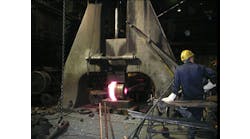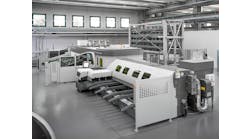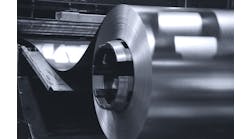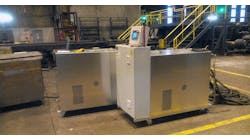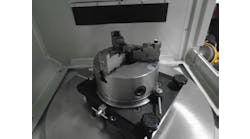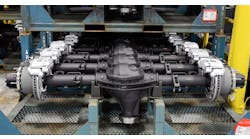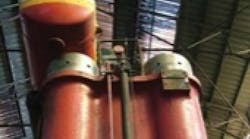A Davy 6,000-metric ton forging press being repaired in the DavyMarkham workshops, Sheffield, England.
With demand for steel forgings still climbing, the production capacity of many large presses is approaching saturation point. This fact is evident in full order books and lead times as long as 12 months, even up to 36 months for the largest forgings (over 150 metric tons.) As a result, press uptime is becoming critical, and any major overhauls must be condensed into a brief annual shutdown period — and this situation is compounded by the age of many presses still in service.
Also, the forging industry has a continuing need for preventative and predictive maintenance to offset the risk of column failures, broken shafts, worn-out gears, and other failed press components that could bring an abrupt halt to production and profits.
Britain's DavyMarkham (www.davymarkham.com), a heavy engineering company headquartered in Sheffield, England, has particular experience in remedial press repairs, especially because many forging presses throughout the world carry the original Davy manufacturer's plate. It is gearing up its service to meet the increasing demand.
Thanks to its manufacturing heritage, inspection capability, and understanding of modern engineering materials, DavyMarkham can provide expert service to return machinery to as-new or improved condition, in considerably less time and at significantly less cost than sourcing new equipment.
What's more, through its class-leading engineering resources and equipment, the company is able to offer a "one-stop shop" for repairs and rebuilds, without needing to contract out specialist or very heavy work. At the same time, its manufacturing and design engineering skills enable it to apply current technology like X-ray imaging, controlled shot peening, and Superbolt multi-jackbolt tensioners to extend plant operating life, particularly where fatigue is considered a problem.
"We can work closely with forging companies to help them minimize production downtime, covering everything from quick-fix remedies to help keep busy plant working for the time-being, through to scheduling complete repairs and rebuilds during routine shutdowns. We can also provide the preventative maintenance and strategic spares that allow forging companies to meet their loss-of-profit insurance and employee liability commitments," claims DavyMarkham's managing director, Kevin Parkin. "Given that new presses can cost up to $20 million and lead times are now anything from two to five years, our repair service offers excellent strategic value, while our market credentials are second-to-none."
Forging steel ingots, using a heavy press or hammer, creates an extremely hostile environment, particularly for sliding bearings, which are key parts in any press. This leads to deterioration and wear of faces in sliding contact and, as wear progresses, the clearance between these faces increases, which can introduce instability. Similarly, threaded fasteners can become loose if sufficient preload is not applied during installation and stage maintenance, leading to fatigue failure of the bolt or press columns and damage to adjacent structures.
Corrosion of forging press components arising from the use of cooling water, especially where the coolant is acidic or high in oxygen content, can lead to premature failure, through corrosion cracking and a loss of fit and accurate location.
A lack of timely maintenance, often due to the pressure of production schedules, can result in missing the start of small service-induced defects and cracking — which then may lead to full fatigue failure. This problem is compounded for very large machines, due to the time and effort involved for inspection and maintenance, and for older equipment, where there is a lack of available spares and worn or damaged components sometimes have to be pressed into service.
DavyMarkham's forging press repair service can mitigate such failures and avoid machine downtime by employing visual inspection, NDT, and FEA techniques to identify components that are subject to working stresses above their fatigue limit and ascertain whether any local environmental factors may be causing unseen damage. It can also extend this inspection service to assist customers when purchasing used presses, by checking clearances, parallelism and other key criteria.
Typically, DavyMarkham first undertakes a visual and dimensional site survey, which coupled with non-destructive testing examination, will help toward planning the work required to restore the machine to full working order. In-situ repairs, involving weld reclamation and machining, often are viable as quick-fix solutions, at least until the next scheduled plant shutdown. Sometimes, however, it is necessary to strip down the equipment and return it to DavyMarkham's purpose-equipped machine shop, exploiting its heavy lifting capabilities for handling jobs up to 350 metric tons.
FEA and other advanced engineering software is used to identify areas that have been subjected to stresses above their fatigue level, and predict whether a component will fail through fatigue cracking. Cracks can be removed by machining or arc gouging, then weld-repaired and enhanced by postweld heat treatment. Controlled shot peening, to introduce compressive residual stress into the steel surface, and superfine polishing, to remove potential crack initiation sites, are practical measures to enhance and extend component life.
Where necessary, DavyMarkham remanufactures components and strategic spares, using reverse engineering and 3D solid modelling where original drawings are not available.
For difficult re-bolting applications, particularly involving high preloads, DavyMarkham employs Superbolt tensioners in place of conventional fasteners, a technique applied to produce the world's largest bolted housing (for a Chinese steelmaker.) Using traditional heat tightening, it is often difficult to achieve accurate preloads, due to the large thermal masses involved, while for very large bolted connections conventional hydraulic tensioning schemes often are impractical.
In contrast, Superbolt technology, featuring multiple jackbolt tensioners, allows precise preloads to be applied to the largest bolt with normal bolting tools and joints remaining tight, even on vibrating, pulsating, or reciprocating equipment, eliminating future stress failure and downtime.

